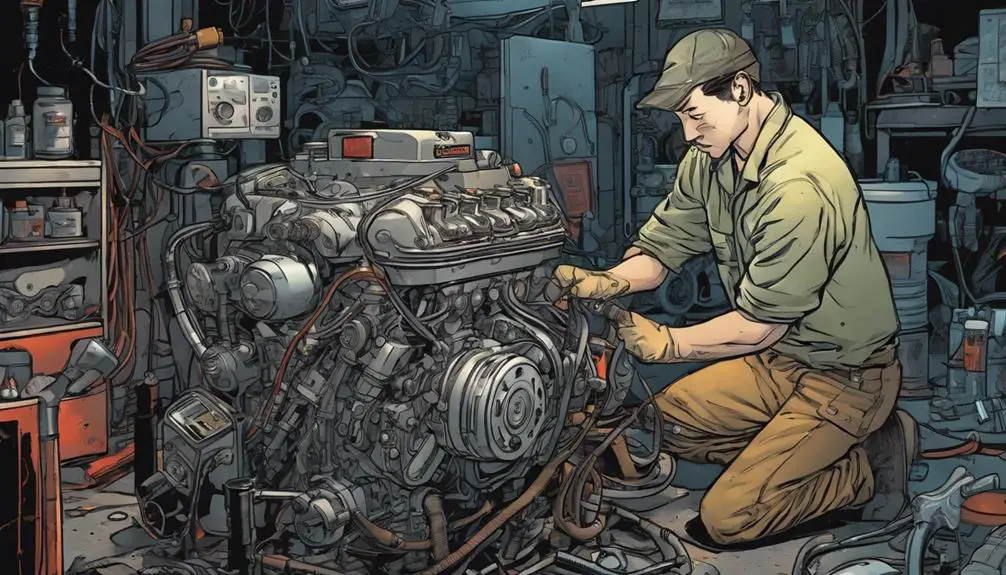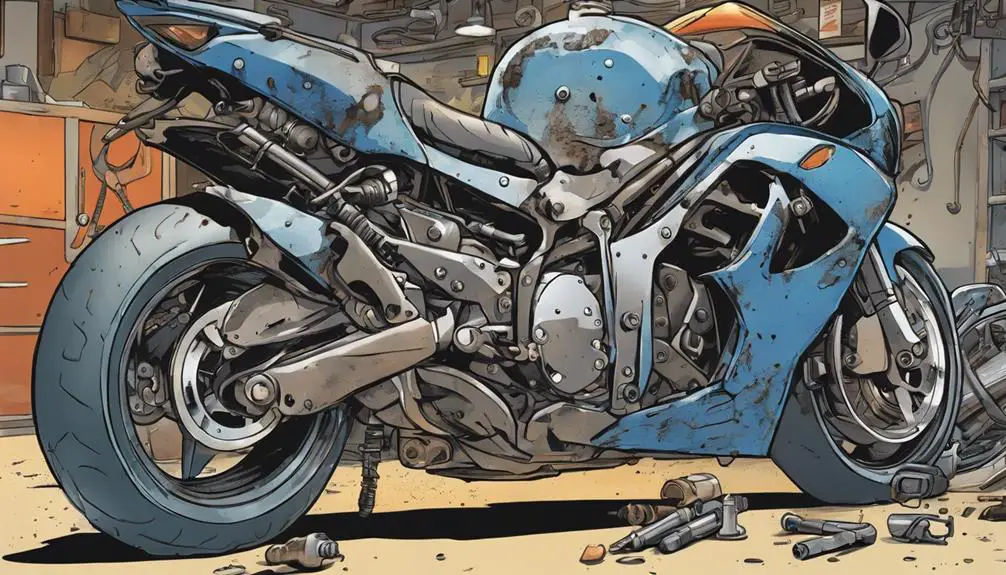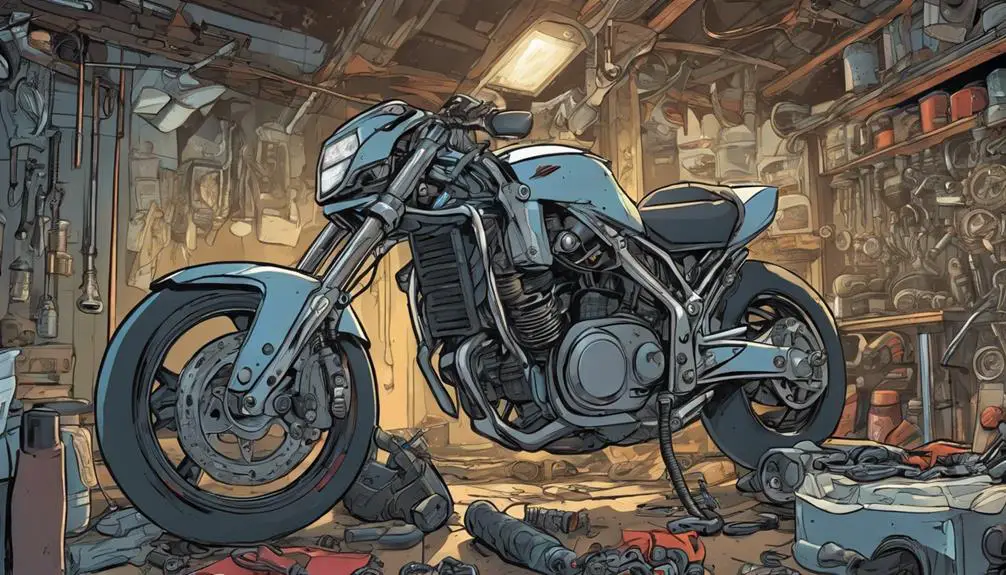Imagine you're racing down the highway on a Hayabusa, feeling the thrill of its power, only to find yourself grappling with engine performance issues that can suddenly stall that excitement. You may not realize it, but maintenance challenges like electrical system failures and brake concerns lurk beneath the surface, threatening both safety and performance. As you ride, it's essential to stay vigilant about tire wear and suspension problems, yet many riders overlook these important checks. What you might discover could greatly impact your experience on the road.
Quick Takeaways
- Engine performance issues, such as rough idling and unusual noises, require regular maintenance to prevent severe damage and costly repairs.
- Electrical system failures, like battery charging problems and flickering lights, necessitate prompt attention to ensure safety and reliability.
- Brake system concerns, including worn pads and degraded fluid, must be addressed with regular inspections to maintain performance and safety.
- Tire wear from uneven tread or improper pressure can significantly affect handling, making regular checks and maintenance essential.
Engine Performance Issues

Engine performance issues in the Hayabusa can greatly impact your riding experience and require timely attention. When you're craving the freedom of the open road, you don't want anything holding you back. If you notice a decrease in acceleration or unusual noises, it's vital to investigate these signs. Ignoring engine problems can lead to more severe damage, costing you both time and money.
Regular maintenance checks are your allies. You've got to stay on top of oil changes, coolant levels, and air filters to guarantee your engine runs smoothly. If you notice rough idling or stalling, it might indicate issues with fuel delivery or spark plugs.
Don't hesitate to consult a professional. A well-tuned engine not only enhances your riding experience but also guarantees your safety on the road.
Electrical System Failures
Electrical system failures can leave you stranded and compromise your safety, so it's essential to address any electrical issues promptly. The Hayabusa's electrical system is intricate, and even minor glitches can lead to major inconveniences. You might find that your battery isn't charging or that lights flicker unexpectedly. These signs are often your bike's way of warning you to take action.
Start by checking connections and ensuring everything is secure. Loose or corroded terminals can cause power loss, making it feel like your bike has a mind of its own. If you notice any blown fuses, replace them immediately and investigate the underlying cause. An unreliable electrical system can jeopardize not just your ride but your freedom on the road.
If you're comfortable with it, consider investing in a multimeter to test voltage levels. This tool can help you pinpoint issues before they escalate. Remember, staying proactive about your electrical system isn't just maintenance; it's a way to preserve your liberty on two wheels.
Don't let an electrical failure clip your wings—stay vigilant, and keep your Hayabusa ready to release its full potential.
Brake System Concerns

When it comes to your Hayabusa's brake system, paying attention to brake pad wear is essential for your safety.
You should also keep an eye on the fluid replacement schedule and make sure you're following caliper maintenance tips.
Let's explore how these factors can keep your ride safe and smooth.
Brake Pad Wear
How often do you check your brake pads, considering their essential role in the Hayabusa's performance and safety? You shouldn't overlook this vital aspect of your ride. Brake pads wear down over time due to friction, and if you ignore them, you risk not just your performance but your safety on the road.
When you feel that your brakes are less responsive or hear unusual sounds, that's your cue to inspect them. Finding the right balance between spirited riding and maintaining your brake system is key to liberation on two wheels. If your pads are worn out, replace them before they affect your rotors, leading to more expensive repairs.
Keep an eye on the thickness of your brake pads. Most manufacturers recommend replacing them when they're down to 3mm or less. Always choose high-quality pads that suit your riding style; this can enhance both performance and safety.
Regularly checking your brake pads is an act of freedom—freedom to ride confidently, knowing your bike's ready for whatever adventure lies ahead. Don't let neglected maintenance hold you back; embrace the joy of riding with peace of mind.
Fluid Replacement Schedule
Ensuring your brake fluid is fresh is just as important as checking your brake pads, as old fluid can lead to decreased performance and potential safety hazards. The brake system relies on hydraulic pressure, and degraded fluid can compromise this essential function.
To keep your ride liberating and safe, make it a point to replace your brake fluid every 1-2 years, or as specified by your manufacturer.
When you change your fluid, consider the type based on your riding style and conditions. If you're pushing your limits on the track or maneuvering through heavy traffic, high-performance fluids can offer better heat resistance.
Don't forget to inspect the brake lines for wear or leaks while you're at it. Even minor issues can lead to significant problems down the road.
Establishing a routine fluid replacement schedule not only enhances your braking efficiency but also supports your overall maintenance strategy.
Caliper Maintenance Tips
Regularly checking and maintaining your brake calipers is crucial for ideal braking performance and safety on your Hayabusa. Start by inspecting the calipers for any signs of wear, such as cracks or leaks. These issues can compromise your braking power, so address them immediately.
Next, clean the calipers to remove dirt and debris that can cause friction or corrosion. Use a soft brush and brake cleaner to guarantee you're not damaging any components.
Don't forget to check the brake pads; worn pads can lead to uneven wear on the calipers. Replace them as needed, and always use high-quality pads designed specifically for your bike.
It's also essential to examine the caliper pistons. Verify they move freely and aren't sticking, as this can affect braking efficiency. If you notice any binding, consider a rebuild or replacement.
Tire Wear and Maintenance
Tire wear can considerably affect your Hayabusa's performance, so it's crucial to keep a close eye on their condition. After all, those tires are your only connection to the road, and worn-out tires can compromise your ride's stability and grip.
Check your tire tread regularly—look for any signs of uneven wear, cracks, or bald spots. If you spot any issues, it's time to replace them.
Don't forget to monitor tire pressure, too. Under-inflated tires can lead to quicker wear and reduced handling. Make it a habit to check your pressure weekly, especially before long rides. You want to feel the freedom of the open road, not worry about your tires giving out.
When selecting replacement tires, consider your riding style and the conditions you typically encounter. Whether you're carving through winding roads or cruising straightaways, the right tires can elevate your experience.
Lastly, remember that regular rotation and alignment can help extend the life of your tires. By staying proactive, you'll guarantee your Hayabusa keeps delivering the exhilarating freedom you crave, while maintaining the safety and performance you deserve.
Suspension Problems

Suspension problems can drastically impact your Hayabusa's handling and comfort, making it vital to address any issues promptly. If you notice unusual vibrations or a bumpy ride, it's time to dig deeper. Worn-out shocks or forks can compromise your bike's stability, leading to a less exhilarating experience on the open road.
Pay attention to any sagging or uneven stance; this could indicate that your suspension components are losing their effectiveness. Inspect the fork seals for leaks, as this can quickly degrade performance, causing you to lose that thrilling connection with the pavement. Remember, your Hayabusa is built for freedom and speed, and a compromised suspension can hinder that liberation.
Regularly check the preload settings to match your riding style and weight. Adjusting these can give you a smoother ride and enhance control, allowing you to conquer every twist and turn. Don't forget to consult your service manual for maintenance schedules specific to your model.
Fuel System Troubles
Fuel system troubles can greatly hinder your Hayabusa's performance, so it's crucial to identify and resolve any issues quickly. If you notice a decrease in power, sputtering, or difficulty starting, you might be dealing with fuel delivery problems. Start by checking your fuel lines for leaks, cracks, or blockages. These can starve your engine of the fuel it craves.
Next, inspect the fuel filter and pump. A clogged filter can restrict flow, while a failing pump can leave you stranded. Don't forget to examine your injectors as well; dirty or faulty injectors can disrupt the spray pattern, leading to poor combustion.
If you're still experiencing issues, consider the fuel quality. Bad gas can wreak havoc on your system, so it's best to fill up at reputable stations.
Regular maintenance is key to keeping your fuel system in check. Cleaning your injectors and replacing filters as needed can liberate your ride from unnecessary headaches.
Common Questions
How Often Should I Change the Oil on My Hayabusa?
You should change the oil on your Hayabusa every 3,000 to 5,000 miles, or at least once a year, depending on your riding style and conditions.
If you ride hard or in extreme conditions, you might want to do it more often.
Regular oil changes not only keep your engine running smoothly but also free you from worries about performance.
Staying on top of maintenance helps you enjoy the ride without hesitation!
What Are the Signs of a Failing Clutch?
If you're riding and notice your bike's engine revs up without a corresponding increase in speed, that's a key sign your clutch might be failing.
For instance, imagine cruising on a winding road, and suddenly, your bike lags behind while you twist the throttle.
You might also feel a slipping sensation or hear unusual noises when shifting gears.
Trust your instincts—addressing these signs early can save you from more significant issues down the road.
How Do I Maintain My Hayabusa's Chain?
To maintain your Hayabusa's chain, start by regularly checking its tension. Adjust it to keep it within the manufacturer's specifications.
Clean the chain with a suitable solvent to remove dirt and grime, then apply high-quality chain lubricant to guarantee smooth operation.
Remember to inspect for wear and replace if necessary.
A well-maintained chain not only enhances your ride but also contributes to your bike's longevity and performance.
Enjoy the freedom of the open road!
What Type of Coolant Is Recommended for the Hayabusa?
Coolant choices can create confusion, but you want to make certain your Hayabusa runs smoothly.
Suzuki recommends using a high-quality, ethylene glycol-based coolant that meets the JASO standard. This helps protect against corrosion and overheating.
Remember, you should always mix it with distilled water for peak performance.
How Can I Improve My Bike's Aerodynamics During Maintenance?
To improve your bike's aerodynamics during maintenance, start by checking for any loose fairings or components.
Tighten everything securely to minimize drag.
You can also consider adding a belly pan or optimizing your windscreen for better airflow.
Cleaning your bike regularly reduces dirt buildup, which can affect aerodynamics.
Finally, if you're feeling adventurous, experiment with bodywork alterations to enhance your bike's sleekness.
Every little tweak can bring you closer to the ride of your dreams!
Wrapping Up
In the world of high-performance motorcycles, neglecting your Hayabusa's maintenance is like inviting disaster on two wheels!
You wouldn't want your engine sputtering like a dying firework or your brakes failing at the most vital moment.
By staying on top of inspections and repairs, you're not just preserving your ride; you're ensuring every twist of the throttle feels like pure adrenaline!
So, gear up and keep that beast roaring—it deserves nothing less than your utmost care!